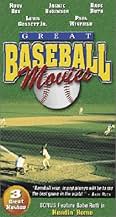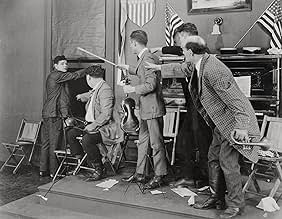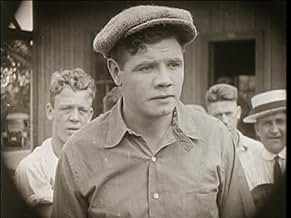The "true story" of baseball great Babe Ruth; Ruth plays himself.The "true story" of baseball great Babe Ruth; Ruth plays himself.The "true story" of baseball great Babe Ruth; Ruth plays himself.
- Director
- Writers
- Stars
Ralf Harolde
- John Tobin
- (as Ralph Harolds)
Charles Byer
- David Talmadge
- (as Charles Burt)
Ann Brody
- Mrs. Tony Marino
- (as Anne Brodie)
Sammy Blum
- Jimbo Jones
- (as Sam Blum)
Tom Cameron
- Deacon Flack
- (as Thomas Cameron)
- Director
- Writers
- All cast & crew
- Production, box office & more at IMDbPro
Featured reviews
The movie hardly makes sense. However, its redeeming value is seeing a young Babe Ruth and the historical footage of the Polo Grounds as it appeared in 1920. The highlight is seeing Ruth at bat in a real game -- the pitcher winds and throws and the Babe swings and hits the ball, and then runs the bases. Terrific stuff. Early in the film Babe takes a turn on the mound. Before he gained fame as a hitter he was an outstanding major league pitcher. The scene involves a sandlot game. I'm not sure Babe gave it his actual windup, but it looked good and professional. The view of the Polo Grounds stands shows the largely male crowd in derby and straw hats. The closing shot was taken from the clubhouse area, which was in back of centerfield. It's too bad all this happens at the very end of the picture.
Babe Ruth - in addition to being perhaps the greatest baseball player ever - had quite a little side-gig going in Hollywood films. He appeared in several - always as "Babe" (usually but not always as Babe Ruth, but always as "Babe.") "Headin' Home" was his first ever appearance in the movies. Yes, he plays "Babe" - a small town boy who makes it to the big time. Was he playing himself? No. The story of this Babe's life is nothing like the story of Babe Ruth's life, but it's still interesting and enjoyable to watch this silent movie.
This Babe grew up in the small town of Haverlock, fiercely devoted to his apparently single mother and his foster sister. The real Babe grew up in a Baltimore suburb until he was farmed out to an orphanage, after which he only rarely saw his family. So this is most definitely not a biography in any way, shape or form, although you get the definite impression that the producers wanted people to think it was a biography and that Babe Ruth was playing Babe Ruth instead of just plain Babe, since the opening shot of the Bambino has him in his Yankees cap.
But since this story bares absolutely no resemblance to Babe Ruth's real life, I'm not going to call it inaccurate; I'm going to assume it's fiction. As fiction, it's pleasant enough and it even tries to be funny, although jokes told on the title cards used in silent movies don't really work very well. It's most interesting for a look at a very young Babe Ruth - before he put on weight. He's pretty slim and trim in this. There's also a bit of politics mixed on that you have to watch for. This was made in 1920. Woodrow Wilson, until he suffered a stroke in late 1919, had been aggressively promoting Senate passage of the Treaty of Versailles that ended World War I. I thought it interesting that, in a veiled sort of way, there was mention of the "14 points" - Wilson's plan that led to the Treaty - and to the League of Nations - Wilson's brainchild that Senate Republicans were fiercely opposed to. There's even a bit of a crazy dogcatcher who's clearly identified as a Republican. Was a political point in favour of Versailles being made? I don't know.
This is an enjoyable, fun movie. (7/0)
This Babe grew up in the small town of Haverlock, fiercely devoted to his apparently single mother and his foster sister. The real Babe grew up in a Baltimore suburb until he was farmed out to an orphanage, after which he only rarely saw his family. So this is most definitely not a biography in any way, shape or form, although you get the definite impression that the producers wanted people to think it was a biography and that Babe Ruth was playing Babe Ruth instead of just plain Babe, since the opening shot of the Bambino has him in his Yankees cap.
But since this story bares absolutely no resemblance to Babe Ruth's real life, I'm not going to call it inaccurate; I'm going to assume it's fiction. As fiction, it's pleasant enough and it even tries to be funny, although jokes told on the title cards used in silent movies don't really work very well. It's most interesting for a look at a very young Babe Ruth - before he put on weight. He's pretty slim and trim in this. There's also a bit of politics mixed on that you have to watch for. This was made in 1920. Woodrow Wilson, until he suffered a stroke in late 1919, had been aggressively promoting Senate passage of the Treaty of Versailles that ended World War I. I thought it interesting that, in a veiled sort of way, there was mention of the "14 points" - Wilson's plan that led to the Treaty - and to the League of Nations - Wilson's brainchild that Senate Republicans were fiercely opposed to. There's even a bit of a crazy dogcatcher who's clearly identified as a Republican. Was a political point in favour of Versailles being made? I don't know.
This is an enjoyable, fun movie. (7/0)
Although the real force of his personality does not come across on screen until the movies could talk, Babe Ruth made a screen debut in this amiable film, purportedly about his life in the small town of Haverlock until him making good with what was his new team in 1920, the New York Yankees.
In fact Babe Ruth grew up on the mean streets of Baltimore where his dad ran a tavern and the family lived on the premises. It's a stone's throw from the Baltimore Orioles new ballpark at the old Camden Rail Yards and the building is a tourist attraction. He had hardly the idyllic small town boyhood we see here.
In fact when his autobiography became a film starring William Bendix as the Babe, with all of that film's weaknesses it does hit more of the real story than Heading Home.
It wasn't uncommon for many sports personalities of the time to make a few extra bucks appearing in films. Those were not the days of multi- million dollar contracts and while Babe became the highest paid baseball player of his day eventually with $80,000.00, that was almost a decade in coming.
Heading Home is a film made to exploit Babe Ruth's fame and if it weren't for him it would hardly merit any notice at all today.
In fact Babe Ruth grew up on the mean streets of Baltimore where his dad ran a tavern and the family lived on the premises. It's a stone's throw from the Baltimore Orioles new ballpark at the old Camden Rail Yards and the building is a tourist attraction. He had hardly the idyllic small town boyhood we see here.
In fact when his autobiography became a film starring William Bendix as the Babe, with all of that film's weaknesses it does hit more of the real story than Heading Home.
It wasn't uncommon for many sports personalities of the time to make a few extra bucks appearing in films. Those were not the days of multi- million dollar contracts and while Babe became the highest paid baseball player of his day eventually with $80,000.00, that was almost a decade in coming.
Heading Home is a film made to exploit Babe Ruth's fame and if it weren't for him it would hardly merit any notice at all today.
This film which purports to chronicle the childhood of the Babe is almost entirely a fabrication....he didn't grow up in some small town....he grew up near the waterfront docks of Baltimore,MD for the first few years of his life where his father owned and ran a saloon that catered to a very rough crowd.Young George was largely unsupervised most of the time and was continually getting into one scrape or another...as a result George Sr had him enrolled in the St. Mary's Industrial School for boys and pretty much stayed out of young George's life from then on...I'm sure this film's version made for better publicity for the up and coming Babe as well as for the Yankees...Colonel Ruppert was very mindful of his team's public image and making a film about the real version of Babe's young life at that time would have had a lot of negative consequences
Babe Ruth comes from a hick town and gets involved in a lot of situations. He ends up as a baseball player.
Whoever came up with this idea should have been hit with a baseball bat. An iconic sports figure, one of the most famous of all time, is reduced to a guy growing up in the sticks, rescuing his kid sister's dog from the pound, breaking up a romance between his girl and a louse, and playing very little baseball. This might be suitable for a Charles Ray film, but not a larger-than-life sports legend. Dull in the extreme, I kept dozing off.
I tried to amuse myself by comparing scenes to other films. For instance, Babe is constantly shown whittling a piece of wood to make a bat, like Joe Don Baker in "Walking Tall."
Then, in an exhibition game in his hometown (in which he inexplicably plays for the visiting team), he breaks a bat. His kid sister then hands him his homemade bat, and he hits a homerun, like Robert Redford in "The Natural" (which of course featured Joe Don Baker as "The Whammer," a Babe Ruth knockoff).
After Ruth hits the homerun (again, for the visiting team), the townspeople chase him all over the place - like a Benny Hill sketch (absent Joe Don Baker).
The beginning of Ruth's career, as a pitcher with the Boston Red Sox, is completely ignored. We see very little footage of him playing for the Yankees, and those scenes are just thrown in without any context. Apparently, the filmmakers thought we'd be more interested in Ruth's life pre-baseball, most of which was made up. Big mistake.
Whoever came up with this idea should have been hit with a baseball bat. An iconic sports figure, one of the most famous of all time, is reduced to a guy growing up in the sticks, rescuing his kid sister's dog from the pound, breaking up a romance between his girl and a louse, and playing very little baseball. This might be suitable for a Charles Ray film, but not a larger-than-life sports legend. Dull in the extreme, I kept dozing off.
I tried to amuse myself by comparing scenes to other films. For instance, Babe is constantly shown whittling a piece of wood to make a bat, like Joe Don Baker in "Walking Tall."
Then, in an exhibition game in his hometown (in which he inexplicably plays for the visiting team), he breaks a bat. His kid sister then hands him his homemade bat, and he hits a homerun, like Robert Redford in "The Natural" (which of course featured Joe Don Baker as "The Whammer," a Babe Ruth knockoff).
After Ruth hits the homerun (again, for the visiting team), the townspeople chase him all over the place - like a Benny Hill sketch (absent Joe Don Baker).
The beginning of Ruth's career, as a pitcher with the Boston Red Sox, is completely ignored. We see very little footage of him playing for the Yankees, and those scenes are just thrown in without any context. Apparently, the filmmakers thought we'd be more interested in Ruth's life pre-baseball, most of which was made up. Big mistake.
Did you know
- TriviaBabe Ruth received $25,000 for this, his first film. The sum was a large amount for the time, and Ruth refused to cash his paycheck and carried it around to show to friends. By the time Ruth had decided to cash his check for the film, the check bounced because of the film's poor box office results. Ruth shrugged off his loss and kept the check as a memento.
- ConnectionsFeatured in Fractured Flickers: Rod Serling (1963)
Details
- Runtime1 hour 11 minutes
- Color
- Sound mix
- Aspect ratio
- 1.33 : 1
Contribute to this page
Suggest an edit or add missing content





















